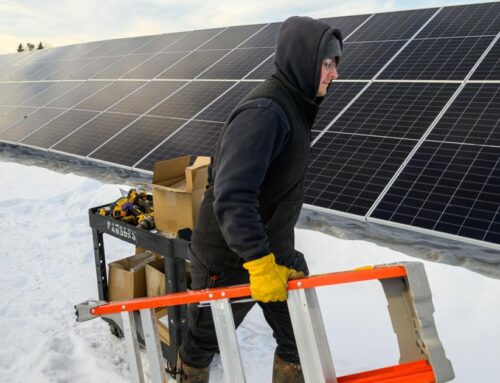Can NASA help predict wildflower super blooms?
April 13, 2025
What if scientists could accurately predict when and where a wildflower super bloom will occur?
NASA researchers are working to do just that — with the help of a fancy device they call an imaging spectrometer. The advanced camera maps and tracks blooms across landscapes in California.
These scientists analyzed native California wildflowers for a recent study and found that both space-based and airborne sensors can monitor the seasonal cycles of blooming plants by detecting one of their signature traits: colors.
“This camera has the capability to let us see what we don’t see as humans with our vision,” said Yoseline Angel, a scientist at NASA’s Goddard Space Flight Center and lead researcher of the study. “Our vision is limited.”
Support for LAist comes from
This kind of data could become a powerful tool for farmers, ecologists and conservationists who rely on flowering plants for food production and ecosystem health. It could even help wildflower enthusiasts track local blooms with scientific precision.

Overview of yellow and orange wildflower blooms around Pine Flat Lake hillsides and along Kings River, California, on March 26, 2025.
Satellite Image Landsat 8&9/OLI
/
NASA Worldview
)
To collect the data, the research team used a state-of-the-art spectrometer developed by NASA’s Jet Propulsion Laboratory in Pasadena. Mounted on an aircraft, the sensor flew over two California nature reserves between February and June 2022 and captured hundreds of wavelengths of light — far beyond what the human eye can see — allowing researchers to monitor the wildflower bloom and its fade throughout the season.
At the same time, scientists on the ground with handheld devices measured how the different flowers reflect light, building a library for each flower type.
By comparing the spectrometer’s data with ground measurements, researchers were able to determine where flowers were blooming in the aerial images and create maps that show blooming patterns over time.
Researchers had never before used the instrument to monitor blooming vegetation for an entire growing season, collecting images each week, said David Schimel, a research scientist with NASA JPL.
Support for LAist comes from
Flowers have a bigger impact on the landscape’s appearance in aerial images than the scientists expected. The team was able to differentiate between flowers, leaves and background cover with 97% accuracy and determine different flowering stages with 80% certainty.
Spectral imaging could be a game-changer for tracking blooms on a regional or even global scale — without needing to hike through every field.
A challenge was differentiating flower colors from leaves, soil and shadows. “Compared to other parts of a plant, flowers can be pretty ephemeral,” Angel said. “They may last only a few weeks.”

NASA’s AVIRIS sensors have been used to study wildfires, World Trade Center wreckage, and critical minerals, among numerous airborne missions over the years.
Shawn Serbin
/
Courtesy of NASA
)
Flowering plants, from crops to desert shrubs, synchronize their bloom cycles with seasonal changes in temperature, rainfall and daylight. However, these patterns are shifting due to climate change, and scientists are eager to track how rising temperatures impact plant life.
Flowers produce pigments that absorb and reflect light in unique ways. Spectrometers can detect these light signatures and identify plants based on their distinct chemical “fingerprints.” This technology has been used for decades to analyze planetary surfaces — including Earth — and is now proving valuable for monitoring plant life from above.
“These sensors are helping us to see what pollinators see,” Angel said, adding that pollinators like bees, birds or butterflies see through different spectral ranges than humans.
Support for LAist comes from
The implications extend far beyond wildflowers. Around 90% of land plants are flowering species, many of which are crucial to agriculture.
Understanding their bloom patterns could help farmers plan harvests and track crop development, assist conservationists in managing habitats and support climate scientists tracking changes over time.

Researcher Ann Raiho measures sunlight interacting with yellow Coreopsis gigantea flowers during field work in the Jack and Laura Dangermond Preserve in California’s Santa Barbara County in 2022.
Yoseline Angel
/
Courtesy of NASA
)
Angel and her team are now analyzing data from a spectrometer aboard the International Space Station, originally designed to map Earth’s desert minerals. By combining those images with environmental conditions, scientists hope to predict when and where massive super blooms — those rare, breathtaking explosions of desert flowers — will occur.
Beyond scientific research, the project has sparked excitement among citizen scientists. Angel, who follows wildflower updates through social media, believes public enthusiasm can complement NASA’s data collection.
“People can help us to observe and report flowers. If they see something like a bloom or super bloom happening, they can always help us to try to enhance our models and [contribute to] science,” Angel said.
Apps like GLOBE and iNaturalist let people be part of the science — by snapping photos and logging what plants or flowers they see, users help scientists study changes in nature and the environment over time.
Search
RECENT PRESS RELEASES
Related Post



